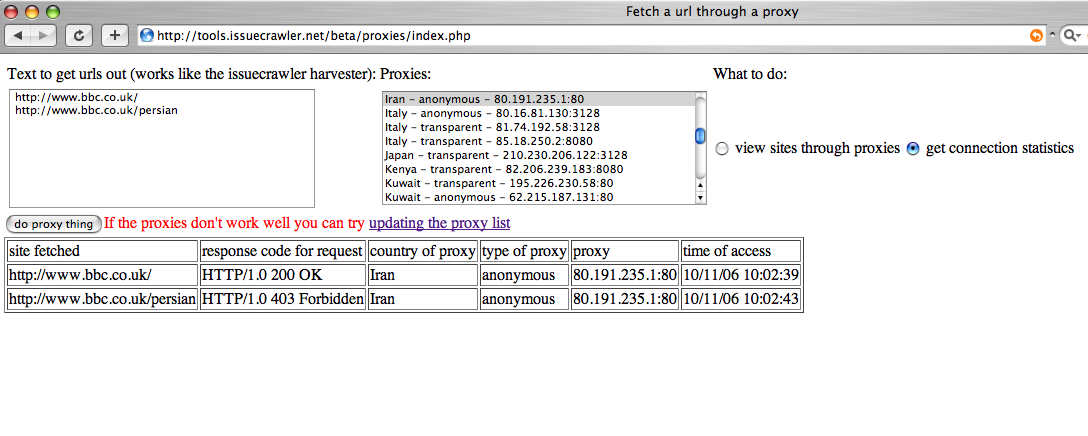You are here: Foswiki>Dmi Web>ToolDatabase>ToolCensorshipExplorer (14 Dec 2008, RichardRogers)Edit Attach
Censorship Explorer
Check whether a URL is censored in a particular country by using proxies located around the world.
Instructions
Input URLs or text into the top box and choose whether you want to request those URLs via your own browser or through one or more proxies.
Each URL inputted will be requested through each selected proxy. Additionally each URL will be requested from our own server in the Netherlands so that a comparison can be made.
The proxy list is regularly updated by scraping free online proxy lists such as freeproxylists.com and xroxy.com. Clicking the proxy will open a new tab for IP lookup service whatismyipaddress.com showing additional details about the proxy. If you cannot find a useful proxy you can specify your own in the bottom box (in the form IP:port, e.g. 192.168.0.22:80).
Although all listed proxies are publicly available on the web they might not all be made accessible intentionally. URL blocking is mostly intentional and web traffic from a proxy to a blocked site may have consequences for the owner of the proxy. Consider the political situation in the country of the proxy you are using w.r.t. the types of URLs you want to request through the proxy.
Sample project
The output is a table with the following columns: 
- the URL requested
- Country of proxy: when you selected a proxy from the list, the country will be specified
- Type of proxy: when you selected a proxy from the list, the type of proxy (transparent or anonymous) will be specified.
- Proxy: the IP address of the proxy, including the port used on that proxy. Clicking the proxy will open a new tab for IP lookup service whatismyipaddress.com showing additional details about the proxy.
- Request time: the time at wich the URL was retrieved through the proxy, in UTC+1.
- Response time: the time it took for the proxy to return our requested URL (the lower the number, the faster the proxy).
- 20 s time out: whether the connection to the proxy timed out or not.
- the response code of the URL fetched through the proxy, as returned in the HTTP headers
- Response code in NL: the response code of the URL fetched through our own server, as returned in the HTTP headers
- Response differs: whether the response codes as returned by the proxy and our own server differ
- RST (proxy): whether the connection to the proxy was dropped by means of a reset package.
- RST (NL): whether the connection from the Netherlands was dropped by means of a reset package.
- redirects (proxy): the number of redirects the tool had to follow in order to get at the final URL
- redirects (NL): the number of redirects for our connection from the Netherlands.
- redirected to (proxy): the final URL retrieved through the proxy
- redirected to (NL): the final URL retrieved from our connection from the Netherlands.
- HTML differs: whether the HTML returned by the proxy and our own server differ. This comparison is might be useful for static pages.
- Do not trust a proxy when it regularly returns response code '-' (something went wrong) or when the field '20 s time out' says 'yes'.
- For a list of response codes and their meaning, have a look at http://en.wikipedia.org/wiki/List_of_HTTP_status_codes. The response code '403 Forbidden' is often a good indication of URL blocking. Verify 403's by visiting the URL through the proxy with e.g. FoxyProxy, you might find an accompanying block page.
- If a connection is consistently dropped through the proxy (as indicated by an RST package) but not through the control connection, this might also be an indication of censorship (e.g. in China).
- To find out more about a particular proxy (e.g. the ISP), consider using an IP lookup service such as http://whatismyipaddress.com/ip-lookup or http://www.whatismyip.com/tools/ip-address-lookup.asp. Clicking the proxy in the resulting table will lead you to whatismyipaddress.com

Other projects using this tool
Dmi ProtocolsProtocols devised by the DMI This page is being replaced gradually by our new research protocols and methods page. Hyperlink Analysis * Perfom an issue craw...
Geo
Geo The Revenge of Geography Place based Space. Idea of spaceless space versus place based space and the connection between cyberspace and geo space. Cyberspa...
Protocol Dynamic Url Sampling
1) Enter data set of URLs in the Censorship Explorer proxy tool. Check connection stats for censored URLs.2) Enter data set of URLs into Issue Crawler. Launch Iss...
Protocol Redistributed Content Discovery
1) Derive issue related sites known to be blocked in a country. 2) Query list of sites for a controversial subject matter or name in Google Scraper. Retain teaser...
Protocol Surfer Rerouting
1) Familiarize oneself with the content of a set of blocked Websites, e.g., women's issues sites blocked in China.2) Query Web for the key words or issue language...
| I | Attachment |
Action | Size | Date | Who | Comment |
|---|---|---|---|---|---|---|
| |
3iran_bbc_proxy.png | manage | 89 K | 12 Dec 2008 - 15:41 | MichaelStevenson | BBC through proxy in Iran |
| |
proxies.png | manage | 9 K | 12 Dec 2008 - 10:38 | AnneHelmond | Tool icon |
Edit | Attach | Print version | History: r6 < r5 < r4 < r3 | Backlinks | View wiki text | Edit wiki text | More topic actions
Topic revision: r5 - 14 Dec 2008, RichardRogers
 Copyright © by the contributing authors. All material on this collaboration platform is the property of the contributing authors.
Copyright © by the contributing authors. All material on this collaboration platform is the property of the contributing authors. Ideas, requests, problems regarding Foswiki? Send feedback



